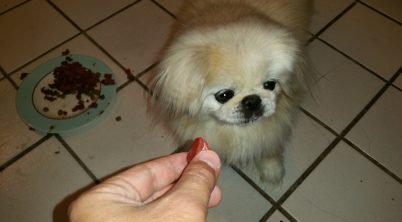The Pekingese, a breed with ancient Chinese origins, is easily recognized by its lion-like mane and distinctive rolling gait. While celebrated for its companionship qualities, this small dog breed is prone to a number of joint issues that may affect its health and mobility. These issues not only compromise the wellbeing of Pekingese dogs but also pose challenges for their owners, who must be vigilant and proactive in managing their pets’ joint health.
Joint problems in Pekingese dogs can range from mild discomfort to severe mobility restrictions. Common conditions such as arthritis and hip dysplasia are frequent health concerns for these dogs. Arthritis leads to the degeneration of joint tissues, causing pain and stiffness, whereas hip dysplasia is a malformation of the hip joints that can progress to arthritis over time. Both conditions tend to manifest as difficulty in movement, visible discomfort, or even limping, particularly in the back legs.
Proper care and preventative strategies are crucial in ensuring the quality of life for a Pekingese with joint issues. Owners are encouraged to maintain a healthy weight for their dogs, as obesity can aggravate joint problems by adding extra stress on the joints. Regular but gentle exercise, a nutritious diet, and consultation with a veterinarian for appropriate pain management or treatment options are essential efforts to mitigate the impact of joint health issues on Pekingese dogs.
Table of Contents
Identifying Joint Problems in Pekingese
Recognizing early signs of joint problems in Pekingese is crucial for timely and effective treatment. The breed is predisposed to various joint conditions that can affect their quality of life.
Early Detection and Signs
Key to managing joint issues in Pekingese is spotting the symptoms early on. Dog owners should watch for signs of lameness or reluctance to move, which can both be indicative of discomfort. Possible signs include:
- Changes in gait: A Pekingese may develop a rolling gait or limp.
- Decreased activity: They may show less enthusiasm for play or resist going on walks.
- Behavioral changes: Look for signs of discomfort, such as irritability or withdrawal.
Common Joint Conditions
Several joint conditions are prevalent in Pekingese, each with distinct features:
- Arthritis: Chronic inflammation of the joints leading to pain and stiffness.
- Hip Dysplasia: Malformation of the hip joint causing instability or dislocation.
- Patellar Luxation: The kneecap slipping out of place, often leading to lameness.
- Intervertebral Disc Disease: Condition affecting the spinal discs, which can lead to pain, nerve damage, and even paralysis.
For a Pekingese showing any signs of joint distress, veterinary evaluation is essential. Early diagnosis can halt the progression of these conditions and improve the dog’s quality of life.
Factors Contributing to Joint Health
Joint health in Pekingese is governed by a host of contributory factors, including genetic predispositions and issues related to obesity and weight management. These aspects are crucial in ensuring a healthy life for these small dogs known for their distinctive physique.
Genetic Predispositions
The Pekingese breed carries genetic quirks that predispose them to certain joint problems. Their unique body shape, characterized by a long back and short legs, can lead to conditions such as intervertebral disc disease. Moreover, genetics may also play a role in their susceptibility to arthritis, a degenerative joint disease that affects the comfort and mobility of these dogs.
Obesity and Weight Management
Maintaining a healthy weight is imperative for the joint health of a Pekingese. Obesity can exacerbate the risk of joint issues due to the increased stress on the skeletal structure. It is essential for owners to provide:
- A balanced diet
- Regular, but not excessive, exercise
Monitoring a Pekingese’s weight not only contributes to overall health but also minimizes the strain on their joints, thus aiding in the prevention of joint-related health problems.
Preventing and Managing Joint Issues
Proper prevention and management of joint issues in Pekingese can significantly enhance their quality of life. Attention to nutrition and exercise is paramount in mitigating the onset and progression of arthritis and other related conditions.
Proper Nutrition
Appropriate nutrition plays a crucial role in maintaining joint health. A balanced diet rich in essential nutrients can help prevent the development of joint problems. The inclusion of supplements like glucosamine and chondroitin may aid in maintaining cartilage health. For Pekingese, portion control is vital to prevent obesity, a known risk factor for exacerbated joint issues. Feeding high-quality dog food that meets the breed’s specific needs is recommended.
Exercise and Activity
Regular, gentle exercise helps sustain joint mobility and muscle strength. For Pekingese dogs, which are small in stature, moderate activities such as short walks or play sessions are beneficial. Exercise should be tailored to the dog’s size and physical condition, avoiding strain on their joints. Starting physical routines early on and maintaining a consistent schedule can greatly aid in the prevention of joint-related ailments.
Treatment Options for Joint Problems
Effective management of joint problems in Pekingese involves a combination of medications, supplements, and therapies. A veterinarian’s evaluation can lead to a tailored treatment plan focusing on alleviating symptoms and maintaining joint health.
Medications and Supplements
Medications:
- Anti-inflammatory medications: These are commonly prescribed to reduce pain and swelling. They help in managing symptoms of arthritis and other joint-related issues.
- Glucosamine and Chondroitin: Both supplements support joint health, potentially aiding in cartilage repair and maintaining joint fluid viscosity.
Supplements:
- Omega-3 Fatty Acids: Known to have anti-inflammatory effects.
- Multivitamins: To support overall health and well-being.
Physical and Alternative Therapies
Physical Therapies:
- Hydrotherapy: Utilizes water resistance for low-impact exercise, aiding in joint mobility and muscle strength without undue stress.
- Controlled Exercise: Helps in maintaining a healthy weight, reducing the strain on joints.
Alternative Therapies:
- Acupuncture: Targets specific points to relieve pain and improve joint function.
- Massage: Can improve circulation and reduce muscle tension around affected joints.
Life with a Pekingese with Joint Problems
Living with a Pekingese with joint problems requires a well-adjusted approach that focuses on enhancing the dog’s quality of life and ensuring they receive appropriate veterinary care. It involves a commitment to understanding and addressing various mobility issues that might affect the dog’s day-to-day activities.
Quality of Life Improvements
For a Pekingese experiencing joint problems, simple modifications can make a vast difference in their daily comfort and mobility. Mobility aids, such as ramps or steps, can empower them to move more easily around the house and minimize the risk of further joint damage. Owners should maintain a healthy weight for their Pekingese, as excess weight can exacerbate joint issues.
Dogs with joint issues often benefit from a soft and supportive sleeping area. Therefore, investing in an orthopedic dog bed is crucial to relieve pressure on sore joints. Regular, gentle exercise is also essential; however, it should be appropriately paced to the individual dog’s tolerance.
Veterinary Care
Regular veterinary check-ups are vital for monitoring the progression of joint problems in Pekingese dogs. These check-ups may include physical examinations and imaging tests such as X-rays. A veterinarian can also recommend a management plan that may consist of medications for pain relief, nutritional supplements like glucosamine, or even specialized treatments like physical therapy.
Veterinary care also involves a discussion about potential surgical options if non-invasive methods do not sufficiently maintain the quality of life. Owners should be prepared for the costs associated with this level of care, and they should discuss with their veterinarian about the most viable options for their situation.
Understanding Surgical Interventions
In the treatment of Pekingese dogs with severe joint problems, surgical interventions can be a critical component. Surgical approaches are generally considered when non-surgical methods have proved inadequate in managing symptoms of degenerative joint disease or when the dog’s quality of life is significantly compromised.
- Total Hip Replacement (THR): They replace the poorly developed joint with prosthetics, aiming to restore function and alleviate pain.
- Femoral Head Ostectomy (FHO): This involves removing the head and neck of the femur, allowing scar tissue to create a false joint.
Spinal Issues Treatments:
- Hemilaminectomy: For cases with intervertebral disc disease, this surgery involves removing part of the vertebra to relieve spinal cord pressure.
- Dorsal Laminectomy: It is another method to decompress the spinal cord, where a section of the vertebrae is removed from the top.
Post-Surgical Care:
- Physical Therapy: Rehabilitation is essential for recovery, consisting of exercises to improve mobility.
- Pain Management: Controlling pain with medications is necessary post-operation to ensure the dog’s comfort.
Before proceeding with surgery, it is crucial for owners to understand the potential risks and benefits. A thorough examination by a veterinary surgeon and a discussion about expected outcomes and aftercare can help in making an informed decision. It is also important that owners consider the financial and time commitments required for post-operative care to ensure the best possible prognosis for their Pekingese.








